Abstract
The protective role of serotype-specific and non-type-specific active immunity against Pseudomonas aeruginosa infection was assessed in granulocytopenic dogs. Dogs were preimmunized with either specific serotype 6 vaccine (SI) or nonspecific serotype 3 vaccine (NSI) and challenged intravenously with 10(7) viable serotype 6 P. aeruginosa during granulocytopenia. Control dogs (C) having insignificant anti-pseudomonas antibody levels were also tested. Results showed: (i) significant increase in survival of SI dogs (P less than 0.05) compared to C and NSI dogs, with no significant difference between C and NSI animals; (ii) lower febrile responses in SI dogs; and (iii) markedly reduced bacteremia in SI dogs compared to C and NSI animals. SI dog sera from survivor animals did not kill the infecting pseudomonas strain in vitro. The study demonstrated that type-specific immunity to P. aeruginosa induced by active immunization is effective in protection against pseudomonas during granulocytopenia and that non-type-specific immunity offers no cross-reactive protection. The findings suggest that the reticuloendothelial system in conjunction with specific immunity constitute an important defense against pseudomonas infections.
Full text
PDF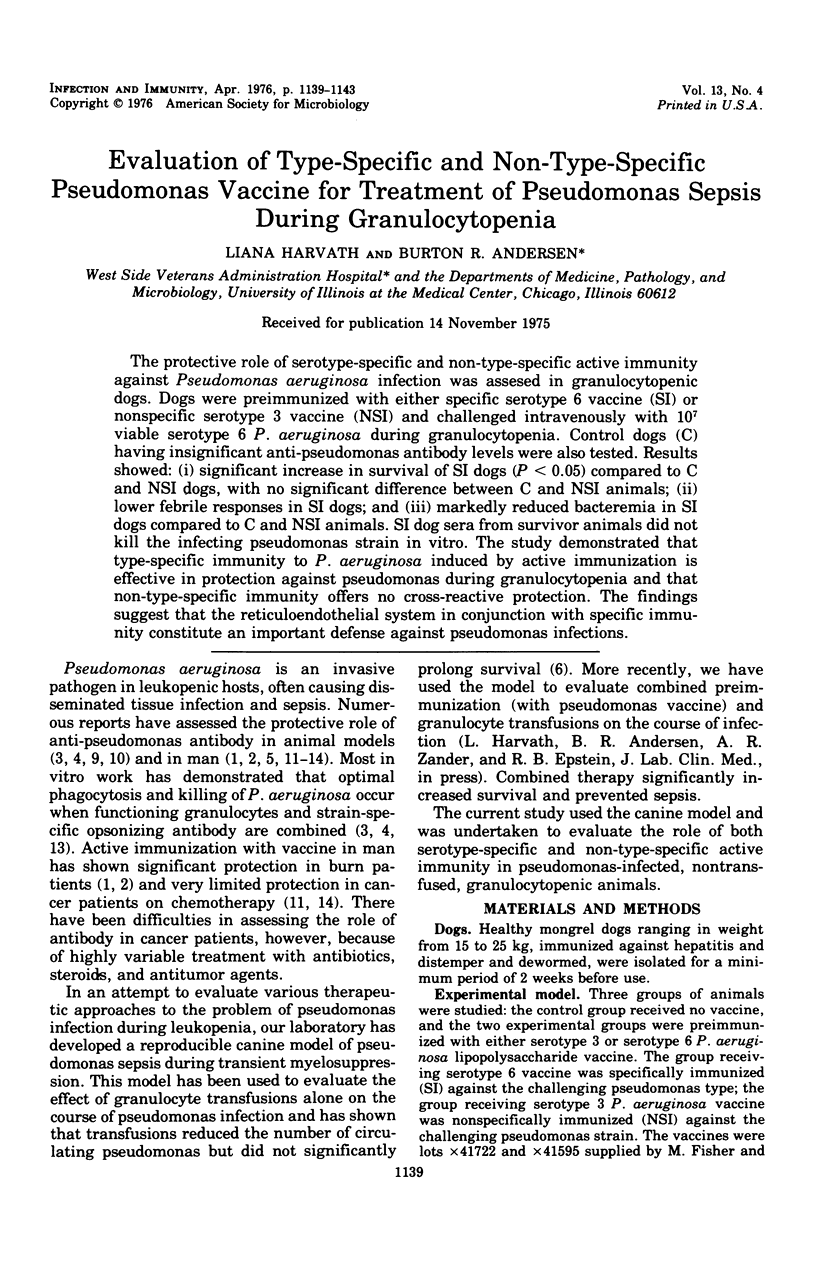
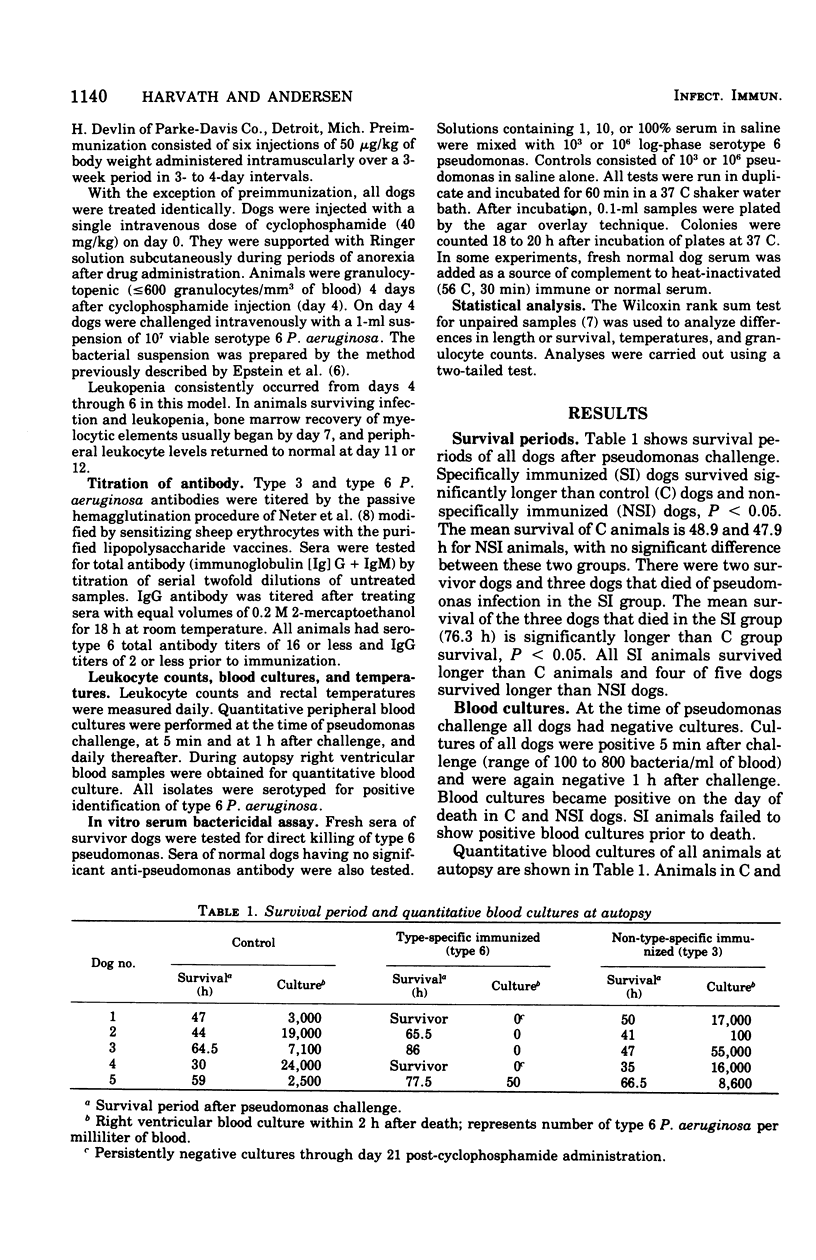
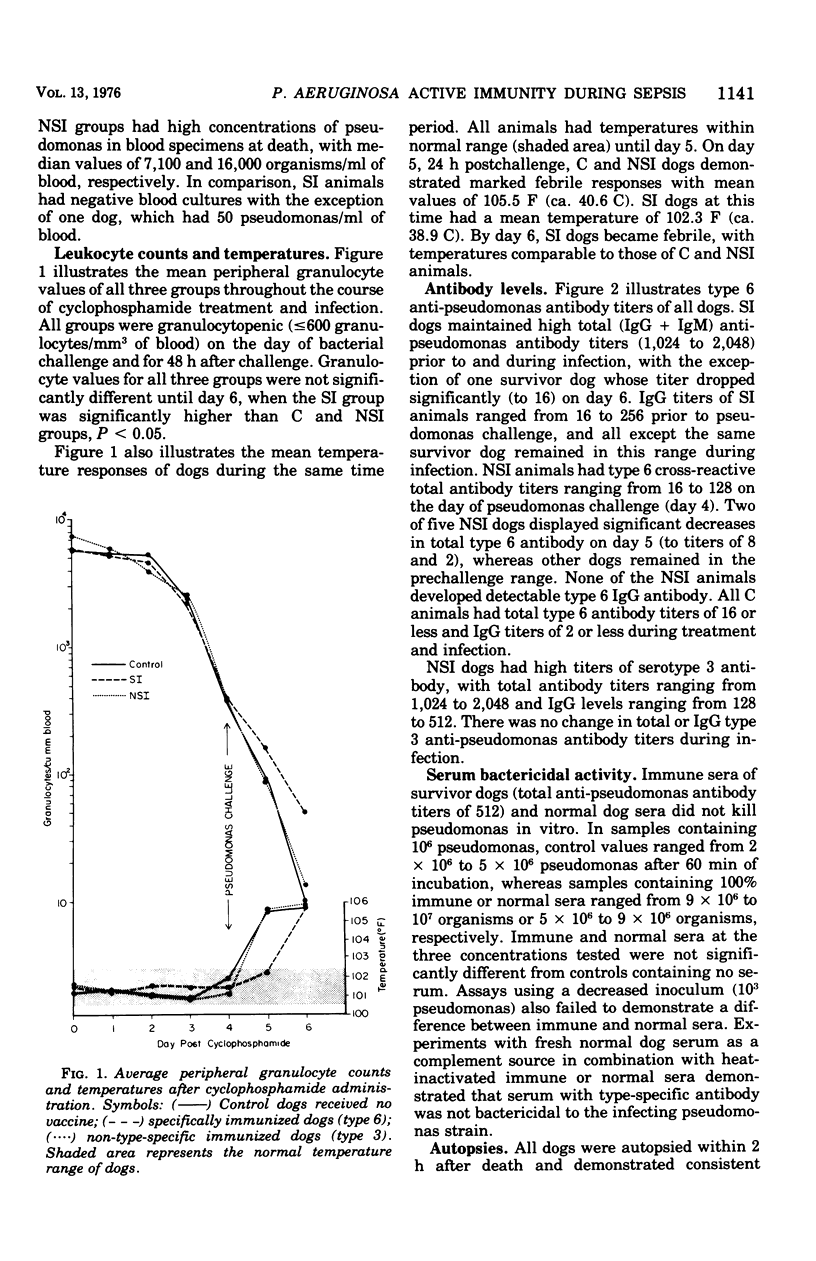
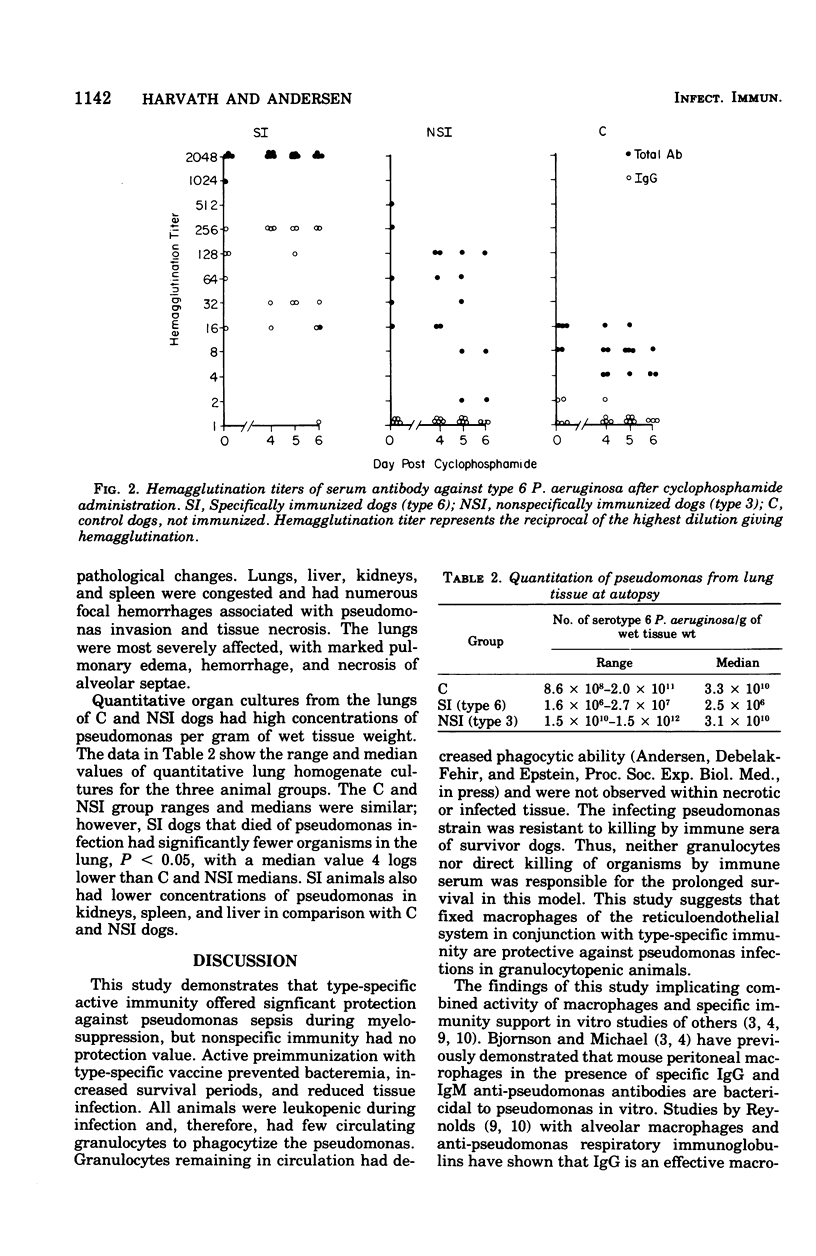
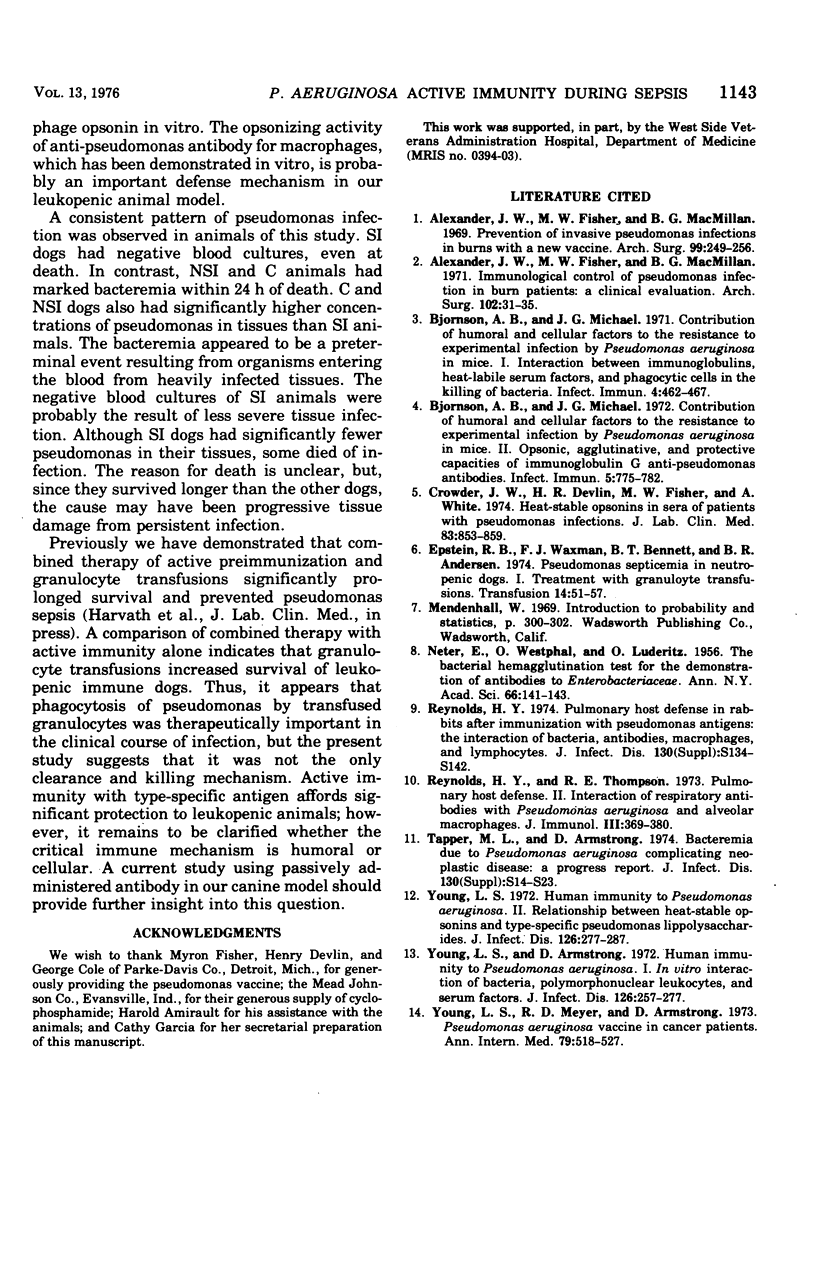
Selected References
These references are in PubMed. This may not be the complete list of references from this article.
- Alexander J. W., Fisher M. W., MacMillan B. G., Altemeier W. A. Prevention of invasive pseudomonas infection in burns with a new vaccine. Arch Surg. 1969 Aug;99(2):249–256. doi: 10.1001/archsurg.1969.01340140121018. [DOI] [PubMed] [Google Scholar]
- Alexander J. W., Fisher M. W., MacMillan B. G. Immunological control of Pseudomonas infection in burn patients: a clinical evaluation. Arch Surg. 1971 Jan;102(1):31–35. doi: 10.1001/archsurg.1971.01350010033008. [DOI] [PubMed] [Google Scholar]
- Bjornson A. B., Michael J. G. Contribution of humoral and cellular factors to the resistance to experimental infection by Pseudomonas aeruginosa in mice. I. Interaction between immunoglobulins, heat-labile serum factors, and phagocytic cells in the killing of bacteria. Infect Immun. 1971 Oct;4(4):462–467. doi: 10.1128/iai.4.4.462-467.1971. [DOI] [PMC free article] [PubMed] [Google Scholar]
- Bjornson A. B., Michael J. G. Contribution of humoral and cellular factors to the resistance to experimental infection by Pseudomonas aeruginosa in mice. II. Opsonic, agglutinative, and protective capacities of immunoglobulin G anti-Pseudomonas antibodies. Infect Immun. 1972 May;5(5):775–782. doi: 10.1128/iai.5.5.775-782.1972. [DOI] [PMC free article] [PubMed] [Google Scholar]
- Crowder J. G., Devlin H. B., Fisher M., White A. Heat-stable opsonins in sera of patients with Pseudomonas infections. J Lab Clin Med. 1974 Jun;83(6):853–859. [PubMed] [Google Scholar]
- Epstein R. B., Waxman F. J., Bennett B. T., Andersen B. R. Pseudomonas septicemia in neutropenic dogs. I. Treatment with granulocyte transfusions. Transfusion. 1974 Jan-Feb;14(1):51–57. doi: 10.1111/j.1537-2995.1974.tb04484.x. [DOI] [PubMed] [Google Scholar]
- GORZYNSKI E. A., LUDERITZ O., NETER E., WESTPHAL O. The bacterial hemagglutination test for the demonstration of antibodies to Enterobacteriaceae. Ann N Y Acad Sci. 1956 Aug 10;66(1):141–156. doi: 10.1111/j.1749-6632.1956.tb40113.x. [DOI] [PubMed] [Google Scholar]
- Reynolds H. Y. Pulmonary host defenses in rabbits after immunization with Pseudomonas antigens: the interaction of bacteria, antibodies, macrophages, and lymphocytes. J Infect Dis. 1974 Nov;130 (Suppl)(0):S134–S142. doi: 10.1093/infdis/130.supplement.s134. [DOI] [PubMed] [Google Scholar]
- Reynolds H. Y., Thompson R. E. Pulmonary host defenses. II. Interaction of respiratory antibodies with Pseudomonas aeruginosa and alveolar macrophages. J Immunol. 1973 Aug;111(2):369–380. [PubMed] [Google Scholar]
- Tapper M. L., Armstrong D. Bacteremia due to Pseudomonas aeruginosa complicating neoplastic disease: a progress report. J Infect Dis. 1974 Nov;130 (Suppl)(0):S14–S23. doi: 10.1093/infdis/130.supplement.s14. [DOI] [PubMed] [Google Scholar]
- Young L. S., Armstrong D. Human immunity to Pseudomonas aeruginosa. I. In-vitro interaction of bacteria, polymorphonuclear leukocytes, and serum factors. J Infect Dis. 1972 Sep;126(3):257–276. doi: 10.1093/infdis/126.3.257. [DOI] [PubMed] [Google Scholar]
- Young L. S. Human immunity to Pseudomonas aeruginosa. II. Relationship between heat-stable opsonins and type-specific lipopolysaccharides. J Infect Dis. 1972 Sep;126(3):277–287. doi: 10.1093/infdis/126.3.277. [DOI] [PubMed] [Google Scholar]
- Young L. S., Meyer R. D., Armstrong D. Pseudomonas aeruginosa vaccine in cancer patients. Ann Intern Med. 1973 Oct;79(4):518–527. doi: 10.7326/0003-4819-79-4-518. [DOI] [PubMed] [Google Scholar]


